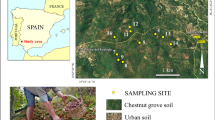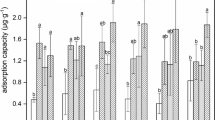Abstract
Former studies on human oral bioaccessibility of polycyclic aromatic hydrocarbons (PAH) from natural soil samples using human in vitro digestive tract models (physiologically based extraction tests, PBET) show highly variable results (0–100 % of mobilized PAH). Apart from other factors, the type and amount of present geosorbents are assumed to be significant for the degree of desorption/release of PAH into the digestive juice. Therefore, in this study, the reference geosorbents pure quartz sand, Na-montmorillonite clay, Pahokee peat, and charcoal “Sommerhit” were spiked with selected deuterated PAH and employed as single materials in a PBET. Lowest bioaccessibility was determined in charcoal, representing black carbon (0.1 ± 0.1 % for ∑10 PAH-d) in contrast to higher bioaccessibility in peat (6.4 ± 2.2 %) and clay (4.8 ± 1.1 %). Highest bioaccessibility was determined in sand (26.9 ± 7.5 %). The results show a systematic impact of heterogeneous geosorbents on human oral bioaccessibility of PAH and particularly black carbon acting as a very strong geosorbent that reduces human health risk.


Similar content being viewed by others
References
Accardi-Dey A, Gschwend PM (2003) Reinterpreting literature sorption data considering both absorption into organic carbon and adsorption onto black carbon. Environ Sci Technol 37:99–106
Cave MR, Wragg J, Harrison I, Vane CH, van de Wiele T, de Groeve E, Nathanail CP, Ashmore M, Thomes R, Robinson J, Daly P (2010) Comparison of batch mode and dynamic physiologically based bioaccessibility tests for PAHs in soil samples. Environ Sci Technol 44:2654–2660
Collins CD, Mosquera-Vazquez M, Gomez-Eyles JL, Mayer P, Gouliarmo V, Blum F (2013) Is there sufficient “sink” in current bioaccessibility determinations of organic pollutants in soils? Environ Pollut 181:128–132
Cornelissen G, Gustafsson Ö, Bucheli TD, Jonker MTO, Koelmans A, van Noort PCM (2005) Extensive sorption of organic compounds to black carbon, coal, and kerogen in sediments and soils: mechanisms and consequences for distribution, bioaccumulation, and biodegradation. Environ Sci Technol 39:6881–6895
Ghosh U, Luthy RG, Cornelissen G, Werner D, Menzie CA (2011) In-situ sorbent amendments: a new direction in contaminated sediment management. Environ Sci Technol 54:1163–1168
Goni I, Serrano J, Saura-Calixto F (2006) Bioaccessibility of β-carotene, lutein, and lycopene from fruits and vegetables. J Agric Food Chem 54:5382–5387
Grøn C, Oomen A, Weyand E, Wittsiepe J (2007) Bioaccessibility of PAH from Danish soils. J Environ Sci Health A 42:1233–1239
Hack A, Selenka F (1996) Mobilization of PAH and PCB from contaminated soil using a digestive tract model. Toxicol Lett 88:199–210
Hansen JB, Oomen AG, Edelgaard I, Grøn C (2007) Oral bioaccessibility and leaching: tests for soil risk assessment. Eng Life Sci 7:170–176
Hawthorne SB, Poppendieck DG, Grabanski CB, Loehr RC (2002) Comparing PAH availability from manufactured gas plant soils and sediments with chemical and biological Tests. 1. PAH release during water desorption and supercritical carbon dioxide extraction. Environ Sci Technol 36:4795–4803
Huang W, Weber WJ (1997) A distributed reactivity model for sorption by soils and sediments. 10. Relationships between desorption, hysteresis, and the chemical characteristics of organic domains. Environ Sci Technol 31:2562–2569
Hundal LS, Thompson ML, Laird DA, Carmo AM (2001) Sorption of phenanthrene by reference smectites. Environ Sci Technol 35:3456–3461
Jonker MTO, Koelmans AA (2002) Sorption of polycyclic aromatic hydrocarbons and polychlorinated biphenyls to soot and soot-like materials in the aqueous environment: mechanistic considerations. Environ Sci Technol 36:3725–3734
Khan S, Cao Q, Lin A-J, Zhu Y-G (2008) Concentrations and bioaccessibility of polycyclic aromatic hydrocarbons in wastewater-irrigated soil using in vitro gastrointestinal test. Environ Sci Pollut Res 15:344–353
Kleineidam S, Schüth C, Grathwohl P (2002) Solubility-normalized combined adsorption-partitioning sorption isotherms for organic pollutants. Environ Sci Technol 36:4689–4697
Lorenzi D, Entwistle J, Cave M, Wragg J, Dean JR (2012) The application of an in vitro gastrointestinal extraction to assess the oral bioaccessibility of polycyclic aromatic hydrocarbons in soils from a former industrial site. Anal Chim Acta 735:54–61
Lu M, Yuan D, Lin Q, Ouyang T (2010) Assessment of the bioaccessibility of polycyclic aromatic hydrocarbons in topsoils from different urban functional areas using an in vitro gastrointestinal test. Environ Monit Assess 166:29–39
Luthy RG, Aiken GR, Brusseau ML, Cunningham SD, Gschwend PM, Pignatello JJ, Reinhard M, Traina SH, Weber WJ Jr, Westall JC (1997) Sequestration of hydrophobic organic contaminants by geosorbents. Environ Sci Technol 31:3341–3347
Mao J-D, Hundal LS, Thompson ML, Schmidt-Rohr K (2002) Correlation of poly(methylene)-rich amorphous aliphatic domains in humic substances with sorption of a nonpolar organic contaminant phenanthrene. Environ Sci Technol 36:929–936
Meleshyn A, Tunega D (2011) Adsorption of phenanthrene on Na-montmorillonite: a model study. Geoderma 169:41–46
Minhas JK, Vasiluk L, Pinto LJ, Gobas FAPC, Moore MM (2006) Mobilization of chrysene from soil in a model digestive system. Environ Toxicol Chem 25:1729–1737
Müller S, Totsche KU, Kögel-Knabner I (2007) Sorption of polycyclic aromatic hydrocarbons to mineral surfaces. Eur J Soil Sci 58:918–931
Oomen AG, Sips AJAM, Groten JP, Sijm DTHM, Tolls J (2000) Mobilization of PCBs and Lindane from soil during in vitro digestion and their distribution among bile salt micelles and proteins of human digestive fluid and the soil. Environ Sci Technol 34:297–303
Oomen AG, Hack A, Minekus M, Zeijdner E, Cornelis C, Schoeters G, Verstraete W, van de Wiele T, Wragg J, Rompelberg CJM, Sips AJAM, van Wijnen JH (2002) Comparison of five in vitro digestion models to study the bioaccessibility of soil contaminants. Environ Sci Technol 36:3326–3334
Oomen AG, Rompelberg CJM, Bruil MA, Dobbe CJG, Pereboom DPKH, Sips AJAM (2003) Development of an in vitro digestion model for estimating the bioaccessibility of soil contaminants. Arch Environ Contam Toxicol 44:281–287
Oomen AG, Rompelberg CJM, Van de Kamp E, Pereboom DPKH, de Zwart LL, Sips AJAM (2004) Effect of bile type on the bioaccessibility of soil contaminants in an in vitro digestion model. Arch Environ Contam Toxicol 46:183–188
Pu X, Lee LS, Galinsky RE, Carlson GP (2004) Evaluation of a rat model versus a physiologically based extraction test for assessing phenanthrene bioavailability from soils. Toxicol Sci 79:10–17
Rotard W, Christmann W, Knoth W, Mailahn W (1995) Bestimmung der resorptionsverfügbaren PCDD / PCDF aus Kieselrot – Simulation der Digestion mit Böden. Z Umweltchem Ökotox 7:3–9
Ruby MV, Davis A, Schoof R, Eberle S, Sellstone CM (1996) Estimation of lead and arsenic bioavailability using a physiologically based extraction test. Environ Sci Technol 30:422–430
Scott WC, Dean JR (2005) An assessment of the bioavailability of persistent organic pollutants from contaminated soil. J Environ Monit 7:710–715
Semple KT, Riding MJ, McAllister LE, Sopena-Vazquez F, Bending GD (2013) Impact of black carbon on the bioaccessibility of organic contaminants in soil. J Hazard Mater 261:808–816
Siciliano SD, James K, Zhang G, Schafer AN, Peak DJ (2009) Adhesion and enrichment of metals on human hands from contaminated soil at an Arctic urban brownfield. Environ Sci Technol 43:6385–6390
Siciliano SD, Laird BD, Lemieux CL (2010) Polycyclic aromatic hydrocarbons are enriched but bioaccessibility reduced in brownfield soils adhered to human hands. Chemosphere 80:1101–1108
Tang X-Y, Tang L, Zhu Y-G, Xing B-S, Duan J, Zheng M-H (2006) Assessment of the bioaccessibility of polycyclic aromatic hydrocarbons in soils from Beijing using an in vitro test. Environ Pollut 140:279–285
Tao S, Zhang D, Lu Y, Li L, Ding J, Yang Y, Yang Y, Wang X, Liu W, Xing B (2010) Mobility of polycyclic aromatic hydrocarbons in the gastrointestinal tract assessed using an in vitro digestion model with sorption rectification. Environ Sci Technol 44:5608–5612
Tilston EL, Gibson GR, Collins CD (2011) Colon extended physiologically based extraction test (CE-PBET) increases bioaccessibility of soil-bound PAH. Environ Sci Technol 45:5301–5308
Van de Wiele TR, Verstraete W, Siciliano SD (2004) Polycyclic aromatic hydrocarbon release from a soil matrix in the in vitro gastrointestinal tract. J Environ Qual 33:1343–1353
Vasiluk L, Pinto LJ, Walji ZA, Tsang WS, Gobas FAPC, Eickhoff C, Moore MM (2007) Benzo[a]pyrene bioavailability from pristine soil and contaminated sediment assessed using two in vitro models. Environ Toxicol Chem 26:387–393
Wang G, Kleineidam S, Grathwohl P (2007) Sorption/desorption reversibility of phenanthrene in soils and carbonaceous materials. Environ Sci Technol 41:1186–1193
Zhu D, Herbert BE, Schlautman MA, Carraway ER, Hur J (2004) Cation-pi bonding: a new perspective on the sorption of polycyclic aromatic hydrocarbons to mineral surfaces. J Environ Qual 33:1322–1330
Acknowledgments
We kindly acknowledge Stefanie Rehrmann for initiating the PBET model setup and Dipl.-Ing. Heiner Kutza, University of Applied Sciences Osnabrück, for particle size measurements.
Author information
Authors and Affiliations
Corresponding author
Additional information
Responsible editor: Philippe Garrigues
Rights and permissions
About this article
Cite this article
Meyer, W., Kons, S. & Achten, C. Impact of reference geosorbents on oral bioaccessibility of PAH in a human in vitro digestive tract model. Environ Sci Pollut Res 22, 5164–5170 (2015). https://doi.org/10.1007/s11356-014-3804-9
Received:
Accepted:
Published:
Issue Date:
DOI: https://doi.org/10.1007/s11356-014-3804-9




